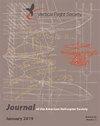结构耦合和旋涡-颤振稳定性的导环
IF 1.4
4区 工程技术
Q2 ENGINEERING, AEROSPACE
引用次数: 0
摘要
本文研究了倾转旋翼的结构耦合问题,不仅考虑了飞行控制系统与柔性结构的相互作用,而且考虑了飞行员的非自愿、高频、生物动力响应可能对气动伺服弹性稳定性造成的潜在不利影响。研究的重点是分析飞机在高速飞行状态下可能出现的副作用,在高速飞行状态下,旋转扑动边界可能会大大减少。一个详细的倾转旋翼模型,代表贝尔XV-15和飞行控制系统已经建立,并加入了一个飞行员生物动力学模型作用于动力杆和中控杆,在文献中可用。此外,一种改进型的XV-15在飞行模式下使用差分集体俯仰代替方向舵进行偏航控制,以显示不同偏航控制设计的影响。稳定性分析表明,倾斜旋翼的结构耦合分析和颤振边界的评估不仅要考虑飞控系统产生的闭环,而且要考虑飞行员非自愿响应的影响。灵敏度分析研究了影响倾转旋翼气动伺服弹性稳定性的最关键参数。最后,讨论了陷波滤波器作为预防手段的使用。本文章由计算机程序翻译,如有差异,请以英文原文为准。
Structural Coupling and Whirl-Flutter Stability with Pilot-in-the-Loop
This paper investigates structural coupling problems for tiltrotors, considering not only the interaction of the flight control system with the flexible structure but also the potentially adverse effects on the aeroservoelastic stability that may be caused by the pilot's involuntary, high-frequency, biodynamic response. The investigation is focused on the analysis of the side effects that could appear at high speed in the airplane flight regime, where the whirl flutter boundaries may be significantly reduced. A detailed tiltrotor model, representative of the Bell XV-15 and of a flight control system has been built and joined with a pilot biodynamic model acting on the power-lever and on the center stick, available in the literature. Additionally, a modified version of the XV-15 using differential collective pitch for yaw control in airplane mode instead of rudder has been investigated to show the effect of different yaw control designs. The stability analyses presented demonstrate that the structural coupling analysis and the flutter boundaries for tiltrotors must be evaluated not only considering the closed loop created by the flight control system but also the effect of involuntary pilot response. Sensitivity analyses examine the most critical parameters impacting tiltrotor aeroservoelastic stability. Finally, the employment of notch filters as a means of prevention is discussed.
求助全文
通过发布文献求助,成功后即可免费获取论文全文。
去求助
来源期刊

Journal of the American Helicopter Society
工程技术-工程:宇航
CiteScore
4.10
自引率
33.30%
发文量
36
审稿时长
>12 weeks
期刊介绍:
The Journal of the American Helicopter Society is a peer-reviewed technical journal published quarterly (January, April, July and October) by AHS — The Vertical Flight Society. It is the world''s only scientific journal dedicated to vertical flight technology and is available in print and online.
The Journal publishes original technical papers dealing with theory and practice of vertical flight. The Journal seeks to foster the exchange of significant new ideas and information about helicopters and V/STOL aircraft. The scope of the Journal covers the full range of research, analysis, design, manufacturing, test, operations, and support. A constantly growing list of specialty areas is included within that scope. These range from the classical specialties like aerodynamic, dynamics and structures to more recent priorities such as acoustics, materials and signature reduction and to operational issues such as design criteria, safety and reliability. (Note: semi- and nontechnical articles of more general interest reporting current events or experiences should be sent to the VFS magazine
 求助内容:
求助内容: 应助结果提醒方式:
应助结果提醒方式:


